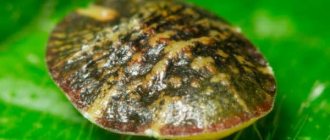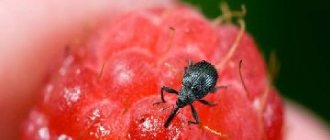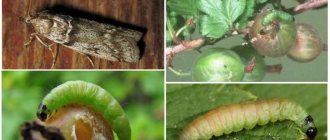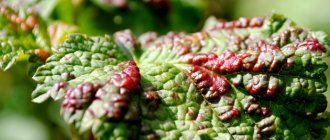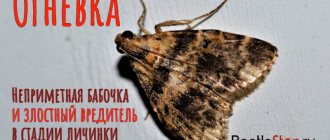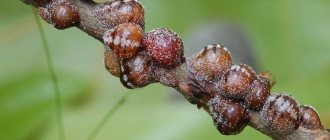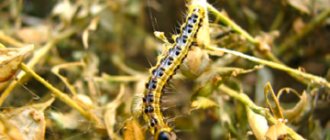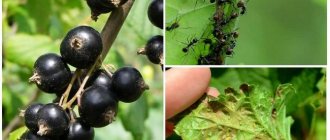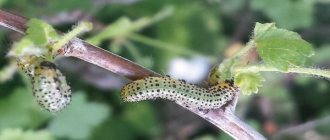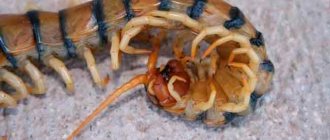Brief description of the moth family
The moth belongs to the division of small lepidoptera of the butterfly family. There are more than 6 thousand species of these insects. Some tropical representatives of moths reach sizes of up to 8.5 cm, but most have insignificant parameters.
Their front wings are triangular in shape, while their hind wings are more rounded and much larger. The colors of butterflies are varied and bright. Insects are active at night. Caterpillars live in grasses, causing significant damage to plantings.
Signs of the appearance of a moth
This pest is not difficult to detect on a plant; you just need to inspect the bush, paying special attention to the berries on it. Thus, small holes can be found on the fruits, from which relatively thin cobwebs stretch to neighboring ones.
Very little time will pass, and there will be many more such spoiled fruits. If you take a closer look at the lump of cobwebs on a gooseberry, you will see that there may be up to six berries inside it, some of which will be completely fresh, while others will be dried out and rotten. As for currants, such a ball often contains up to 12 berries.
Over time, the lump of such eaten fruits will only increase in size, and the caterpillars will gradually leave the berries and go down under the bush. Usually they do not crawl far and are placed 30 cm from the plant stem.
- when the moth spreads in the garden, in addition to the presence of caterpillars, many berries on the bushes rot and become covered with cobwebs;
- the presence of a colony of gall midges can be recognized by swollen areas (galls) in the habitats of the larvae;
- the emergence of parasitic weevils is notable for the absence of currant berries;
- The appearance of leaf rollers is notable for their curled leaves, shrouded in a light layer of cobwebs.
Signs of fire damage
Moth caterpillars infect the leaves of the plant, causing curling, changes in structure and wilting. The appearance of thin cobwebs, excrement and skins of caterpillars is observed. Upon careful inspection, hairy green caterpillars can be found in the foliage, and the ground around the plant is strewn with the remains of leaves and insect waste products. Losing its leaves, the plant quickly dries out and dies. Damaged currant berries turn brown early, and their tops begin to rot, after which the fruits fall off. If you do not fight the insects, you can lose almost the entire crop.
The most common pests
Ognevka
The most common one, the gooseberry moth, is a representative of the biological order Butterfly. It has small dimensions and gray wings. The location of the pupae of wintering moths is in the soil, under bush currant plantations, which complicates the process of controlling moths on currant bushes.
Their appearance occurs in the spring when the air temperature is stable and warms up to 13°C. The cavities of currant bush flowers serve as a reservoir for the ovipositor. The number of moth individuals on one bush can reach two hundred. Caterpillars appear a week after laying eggs. You need to know what the currant moth cannot tolerate and how to deal with its appearance, otherwise its constant presence in the garden will lead to the death of the currant planting. Timely measures taken to combat the gooseberry moth will allow you to preserve the ripe crop.
Damage to gooseberry moth
Important! The moth caterpillar is one of the most active fruit eaters. One insect does this instantly, eating 15 pieces of a ripening currant crop at a time.
You can treat currant bushes in the fall against pests, which counteracts the appearance of insects such as caterpillars and parasitic larvae, using the following folk methods:
- Boil a kilogram of dried wormwood with a small amount of water for 15 minutes. The wormwood solution is diluted with 10 liters of water;
- Finely chop 1 kilogram of tomato tops and place in 11 liters of water. After boiling for half an hour, add 40 grams of laundry soap;
- Pour 100 grams of finely chopped hot pepper pods into a liter jar of water. After boiling for an hour, leave for two days. Filter, dilute with water in the ratio of half a glass to 10 liters of water and add 40 grams of laundry soap to the product.
The drug Fitosporin Treatment
with boiling water is considered a universal remedy for the fight against parasitic insects. However, despite the fact that pouring boiling water only strengthens the bush planting, it should not be 100% strong - it must be allowed to cool for some time. All branches must be tied together before treatment using hot water.
Note. It is permissible to process a currant bush in winter, but only if the leaves completely fall off at the very end of autumn, before the onset of the first cold weather.
Any planting in a garden plot with the onset of summer may be subject to invasion by parasitic insects. To preserve the harvest, it is necessary to take measures to eliminate pests in a timely manner, preferably in the spring, at the end of March.
Gooseberry moth pupae overwinter in the upper layers or in cracks of the soil at a depth of 5-7 cm under gooseberry or currant bushes in cocoons made of cobwebs. In the spring, during the period of bud formation on berry bushes and the beginning of flowering, a massive emergence of the gooseberry moth occurs, which lasts for a whole month.
Females begin to lay tiny, oval-shaped, white eggs in flowers, buds and even on the ovary. The clutch of one adult individual reaches 200 pieces. Egg maturation lasts approximately one week. The hatched caterpillars, up to three millimeters long, are white-yellow in color. Only one individual remains in each ovary, the rest move to other flowers.
The voracious caterpillars of the gooseberry moth begin to destroy seeds and juicy berries, entangling them in a web. One pest can eat about fifteen currants or from five to seven gooseberries. Adult moth caterpillars are green in color and have a black head. Their length can vary from 8 to 14 mm, and there are round black spots on the sides. The gooseberry moth in the photos presented on the site will allow you to get acquainted with all stages of insect development.
During the season, only one generation undergoes complete development. The length of time the moth stays in the caterpillar stage before pupation depends largely on weather conditions and the type of food. On gooseberries, the individual develops more intensively. On black currants, this period can last a week and a half longer and is approximately a month.
The gooseberry moth causes enormous damage to currant and gooseberry bushes. Bushes entangled in cobwebs and damaged, browned berries have an unsightly appearance. Having carefully examined the fruits of gooseberries or currants, you can notice small holes on them, from which cobwebs stretch to neighboring berries. If measures are not taken in time and the fight against the pest is not started, the damage caused can take on catastrophic proportions.
Having information that gooseberry pupae of the pest overwinter in a cocoon, which is located in the top layer of soil directly under a currant or gooseberry bush, it is necessary to carry out the following measures:
- dig up the ground under the bushes throughout the season, and closer to autumn, carry out deep hilling of the plantings to a depth of 12 cm,
- unhilling of treated plants after flowering,
- plant tomatoes and mint near the berry bushes,
- promptly thin out gooseberry and currant plantings to ensure ventilation and access to sunlight,
- if damaged fruits and foliage are found, remove them, preferably with caterpillars,
- attract natural enemies of the gooseberry moth to the site, which destroy caterpillars and pupae. These include ground beetles and horsemen of the braconid family.
These techniques will help significantly reduce the number of pests.
Traditional methods
You can fight gooseberry moth using folk recipes. These techniques will be effective if the situation is not at an advanced stage. Popular wisdom recommends:
- when the berry bushes are flowering, stick branches with blossoming elderberry inflorescences into their middle,
- apply dust powder to the ground under the bushes,
- spray the plants with mustard tincture, pine extract, infusion of tomato tops and ash,
- in the flowering phase, treat the plantings with decoctions of tobacco and wormwood,
- To destroy gooseberry moth caterpillars, use a solution of green soap.
If all of the above methods do not give the desired result, then you should move on to chemicals.
Chemicals
For ardent opponents of chemistry, the use of light traps is recommended. This method of counting insects has become especially popular recently. It allows you to determine the periods of parasite spread. The device can be made from brightly colored cardboard, mainly yellow and orange. The surface is covered with a special long-drying glue. After a while, the entire trap will be covered with butterflies.
Commonly used insecticides include:
- "Kinmiks." The drug is effective against caterpillars and butterflies.
- "Spark". Tablet form of release, requiring preparation of a working solution.
- "Karate". It has a wide spectrum of action, kills pests at all stages of development - from caterpillars to adults.
The use of potent drugs requires compliance with basic safety rules.
Squad gooseberry moth photo female
We are talking about a butterfly insect representing the order Lepidoptera. Wingspan from 24 to 36 mm. The color of the moth can be either brown-gray or dark brown. An oval white stripe runs along the costal margin. The forehead is slightly convex and covered with scales, which ultimately forms a cone shape. The butterfly's head is equipped with filament-shaped, short-ciliated antennae. At one time, a sexually mature female lays up to 200 eggs.
In one season, only one generation undergoes complete development. Although, if external conditions are favorable - the summer is dry and hot, then another facultative generation may appear. The insect overwinters in the state of a pupa, formed from a parchment-like material of brown color.
The larva is a gray-green caterpillar reaching 8-14 mm in length with a black head. The sides are decorated with round black spots with a shiny sheen.
We suggest you read: How to get rid of caterpillars on tomatoes
When considering the question of how to spray gooseberries, you need to pay attention to currant bushes. The firebug will never miss these bushes. It is not the butterfly that is harmful to plants, but the caterpillar. It produces a web that weaves around the foliage, flower stalks and fruits of berry bushes. The diet of the moth larvae consists of the core of gooseberry fruits - it gnaws out all the internal contents.
No weeds under the bush and loosened soil
- We have already indicated that the moth overwinters in a cocoon, which it builds in the surface layer of soil immediately under the bush. This fact is another reminder of the need to periodically dig up the soil under the bush throughout the season, and closer to autumn it needs to be covered with 10-12 cm of soil. In the spring, the insect will not be able to overcome such a “bastion” and there will be no flight of butterflies, but in order for the bush to develop normally by summer, the earth bank must be raked.
- You will definitely not get the gooseberry moth close to it if you plant tomatoes or mint around the bushes.
- If damaged leaves or fruits appear, they must be removed manually and destroyed.
- Attracting ground beetles (the moth's natural enemies) to the site is also a reasonable solution. It’s not at all difficult to create favorable conditions for these useful bugs; just cover the ground around the bushes with roofing felt or roofing felt - they really love such shelters.
- The bushes should not be planted close to each other - good air circulation and plenty of sunlight are necessary.
"Old-fashioned" methods
Wood ash is the enemy of the moth
- Spraying with wood ash. You need to take 3 kg of ash and sift it through a fine-mesh sieve. The resulting powdery component is poured into a bucket (10 liters) of water. This composition is left alone for 48 hours. Next, you need to strain it and use it for its intended purpose - spray gooseberry and currant bushes.
- Dust, although a chemical preparation, has been used as a folk remedy for a very long time. You need to make a 12% aqueous solution from it and treat the ground around the bushes. And to consolidate the effect, after 8-10 days you need to scatter 50 g of dust powder under the bush.
- Infusions from tomato tops. It is necessary to spray three times every 7 days.
- The fight against gooseberry moth can also involve treatment with pine extract. It is prepared according to this recipe: 200 g of spruce or pine needles are poured into 2 liters of hot (not boiling water) water. This composition is infused covered for 7 days, with daily stirring. Spraying is carried out several times, previously diluted in a ratio of 1:10 with an aqueous composition.
- Mustard tincture. Mustard powder is used. 100 g of it is poured into a bucket of water. Infusion period – 48 hours. Before processing the berry bush, the composition must be filtered and diluted in a ratio of 1:2.
Methods for controlling currant moth
There are many ways to eliminate pests from currants. To do this, they use agrotechnical measures, treat the shrubs with chemicals, and also resort to folk remedies. The weather helps get rid of moths, since pests die from fungal diseases during rainy and warm summers.
Agrotechnical measures to combat moth
They are carried out from early spring to late autumn, and thanks to agrotechnical treatment, the plant becomes healthy and does not succumb to the influence of insects, and a bush weakened by weeds will suffer more from pest attacks. It is important to remove fallen leaves around the bush 2 times a year - in spring and autumn. It is necessary to promptly prune diseased branches and thin out shrubs. For better penetration of nutrients and air exchange, the plant is hilled and the soil around it is loosened.
Treatment of currants with chemicals
Chemical preparations for moth
The fight against moth brings excellent results if chemicals are used. You need to choose insecticides based on the period of currant development (before flowering, after flowering, during fruit ripening). The following chemicals should be selected according to development phases:
- Before flowering in early spring, “Kinmiks” should be used (working solution concentration – 0.05%); Iskra M (0.1%). Spraying with these preparations will get rid of a significant number of caterpillars and protect the fruits from damage.
- After flowering, it is recommended to spray currants with Fufanon (0.2%), Actellik (0.2%), and Karbofos (0.2%).
- During the period of fruit ripening, the use of chemicals is strictly prohibited, but in order to protect the berries from pests, it is recommended to spray with biological products: “Fitovermom” (0.3%), “Bitoxibacillin” (1%), “Lepidocide” (0.3%) .
Prevention of moth on currants
Prevention of pest damage must be carried out throughout the year. In early spring, mulch the root area of the shrub. To do this, crushed stone, gravel are poured around the trunk, and roofing material is laid, which will not allow the moth caterpillars to get out of the soil after wintering. In summer, preventive spraying is carried out to destroy caterpillars and their nests.
In late autumn, it is necessary to dig up the soil, which will greatly harm the pupae overwintering in the ground. To prevent damage by insects, it is necessary to regularly prune diseased currant branches and remove weeds in a timely manner.
Preventive measures
In order to directly protect currant, gooseberry and raspberry bushes from insect pests, it is necessary to carry out preventive measures from the beginning of the spring to the end of the autumn seasons:
- Before flowering , cover the soil in the tree trunk circle with mulching material. This will prevent the bugs from crawling out of the ground after wintering.
- In the summer - treatment of bushes for preventive purposes, mechanical (manual) collection of damaged berries and cocoons with cobwebs on them.
- In the autumn , digging up the soil and hilling up the bush to prevent pests from overwintering and crawling out of the ground.
- When planting shrubs, leave at least one meter between bushes. Otherwise, in a heavily dense planting, it will be very difficult to cope with butterflies.
- Regular pruning and thinning throughout the growing season.
It is also important to know that the resistance of berry crops to pests depends on their variety, weather conditions, the presence of diseases, temperature and air humidity.
If spring is quite warm and started early, the moth attacks early varieties of currants and gooseberries. But if spring started late and is quite cold, the moth prefers to directly attack later varieties of berry crops.
Currant varieties resistant to fireweed
To date, there are no currant varieties that are completely resistant to the attacks of the moth. Currant varieties with early flowering and ripening berries suffer more from the pest. This is due to the early emergence of the pest from hibernation. However, there are some varieties of currants that the caterpillar is not very willing to eat. The currant variety “Ariadna” has the highest degree of resistance to various pests, which can be grown in both northern and southern regions.
All shrubs will be less damaged by insect pests if they are adequately adapted to the climatic conditions of their growth and the supply of sufficient moisture and sunlight to the plant.
All methods of combating currant moth are quite good and, if used correctly, will help get rid of the pest. It is important to combine several methods. For example, agrotechnical measures and treatment with chemical or folk remedies. A targeted integrated approach will help, if not “defeat” the harmful insect, then minimize the manifestations of its aggressive life activity.
Fighting moth with folk remedies
Traditional methods will help protect currant bushes, many recipes of which consist of ingredients available in the arsenal of every gardener.
Folk remedies for fireworm
Traditional recipes (they can be used throughout the flowering period with an interval of at least 5-6 days):
- Chamomile. Two methods are used for processing:
a) Pharmaceutical chamomile. To prepare the treatment solution, you need to pour 50 g of flowers into 5 liters of boiling water and leave for two to three hours. After the solution has cooled, spray the currants with it; carry out the work a week after the first flowering.
b) Dalmatian chamomile powder. The product is used to dust the bushes; work should be carried out periodically every 5-6 days.
- Wood ash. Spraying procedures should be carried out during fruit ripening. Instructions for preparing the solution: 1/3 of a 10-liter bucket is filled with ash, the rest is filled with water and left for two to three days in a place without sunlight.
- Mustard. Mustard powder tincture is used during fruit ripening. To prepare the solution, you need to dilute 50 g of mustard powder and 5 liters of hot water, leave for two days, then spray the currants with a spray bottle.
- Coniferous concentrate. To prepare the product, you need to dilute 2 tablespoons per 10 liters of water; the plant is treated with the solution by spraying throughout the flowering period, at weekly intervals.
- Traps. In summer, it is recommended to place light traps near currants. To make them, you need to take bright yellow cardboard and apply glue to it. Such designs will get rid of a large number of adult individuals.
- Elder. To prepare the solution, you need to dilute 10 g of dried elderberry flowers in 1 liter of water and let it brew for two days. After the infusion, you need to strain and spray the currants with it.
Currant care
Currant moth: how to fight?
If the bush is weak and damaged, then it is the first target for various pests. Therefore, to avoid encountering them, it is necessary to properly care for the plant. Certain actions will also help you avoid becoming acquainted with this pest.
- If you dig up the soil before the start of the winter season, then the caterpillars, which burrow into the ground for the winter, come up to the top during digging. Which makes it impossible for them to survive winter frosts. It is necessary to dig to a depth of 5 cm so as not to damage the root system of the shrub.
- Moth pupae choose places close to the trunk as shelter from winter frosts. To prevent the appearance of the moth in the summer, with the onset of autumn it is necessary to hill up the soil. To do this, around September-October, the soil needs to be well loosened and covered with a mound about 10 cm high.
When spring comes, the pupae will become butterflies that will not be able to get out from under such a layer of earth, nor will they be able to lay eggs.
- It would also be a good idea to mulch the soil in the spring. To do this, you need to take compost or peat (about 10 cm) and add it at a distance of 40 cm from the trunk. This measure will also block the exit of the moth from underground.
- If you notice the appearance of the moth in time, and it did not have time to cause severe damage to the berries, then you can simply collect those that have already been damaged. This way you will be able to keep the fruits intact.
Which method to choose depends only on the summer resident himself. Each of them will bring good results.
What does a fireweed look like?
The gooseberry moth is a small gray butterfly with a wingspan of up to 0.3 cm. The front pair is gray with brown stripes and white scales, and the back pair is much lighter than the front and has a black edge.
The caterpillars of the pest are somewhat smaller and reach a length of about 1.2-1.4 cm. The caterpillar has a light body, on which dark blurry stripes are clearly visible.
The anal and pectoral shields are brown, and the head is black. The brown pupa of the pest reaches 9 mm in length and has 8 curved spines on the cremaster. She spends the entire winter in the very top layer of soil, and with the arrival of spring and the appearance of buds on gooseberries and currants, butterflies appear from the cocoons.
To know how to deal with the moth, you should thoroughly study the currant enemy in order to timely detect its presence on the bush.
If you find that the currant berries have begun to turn red ahead of time, and many of the fruits have small holes from which thin threads of cobwebs are visible, rest assured that this small moth caterpillar has begun to actively take over your currant bushes.
The caterpillar has a greenish color, and its small head is painted black. It is worth noting that this individual feeds on fruit pulp and seeds. And if you do not urgently begin to fight this parasite, then the loss of most of the crop is guaranteed.
The fact is that the affected berries quickly begin to dry out and acquire a brownish color. Moreover, if the moth appears in your currant grove, then if measures are not taken in a timely manner, there is a high probability of losing the entire harvest.
Prevention
In order not to carry out expensive treatments of Viksne, Jonker van Tets and other varieties of currants with biological or contact insecticides, it is enough to constantly carry out the full cycle of agrotechnical measures. Let's just add:
- planting moths between the rows of natural enemies, the smell of which repels insects;
- covering the soil with dense material that prevents butterflies from flying out in early spring;
- By hanging feeders in the garden and feeding tits and other birds during the hungry winter season, you can protect the garden from hordes of caterpillars. Birds that make nests near a site can destroy up to 60-70% of insects.
